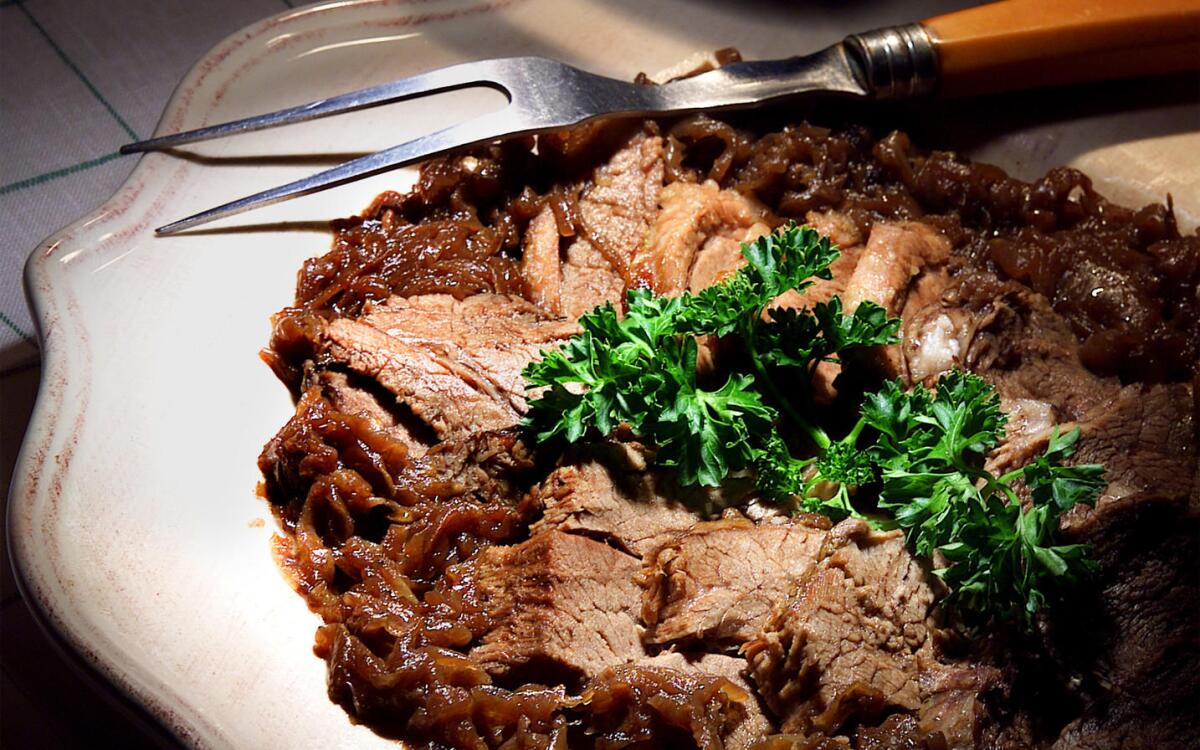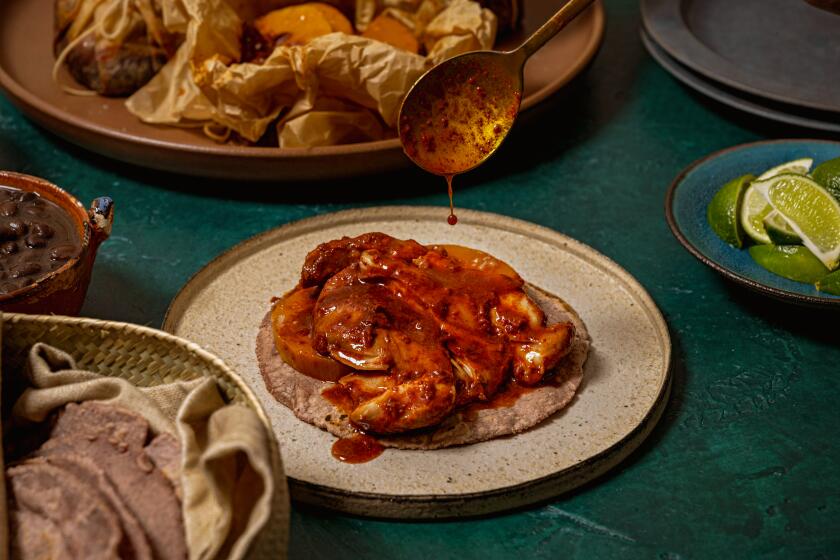Pot Roast With Onion Marmalade

- Share via
I don’t know whether I’m getting smart or getting lazy; the older I get, the harder it is to tell the difference. But lately I’ve been finding that when I cook dishes I’ve made for years, I’m looking more and more for the easiest way to do things. That doesn’t mean leaving out ingredients or settling for less-than-delicious food so much as simplifying techniques.
A dinner a few weekends ago is a good example. It was raining and we were having neighbors over, so my wife asked me to make a pot roast. Ever since I started playing with high-heat braising several years ago, this has been one of my favorite dishes. It sounds crazy, but cooking a chuck roast in a cast-iron pot at 450 degrees for 2 hours gives you meat that is so tender it practically falls apart in buttery chunks.
The first time I tried this high-heat braising, I was skeptical. And so were the meat scientists I called afterward, trying to figure out why it had worked so well. The closest I can come to describing it is that somehow, each individual muscle fiber becomes separate and distinct (indeed, leftovers make great shredded meat for stews or sandwiches). Because of the high heat, all of the connective tissue and fat melt, leaving the once-tough meat so tender you can spoon it apart.
This technique is good not only for chuck roast, but for other tough cuts of beef as well. And I’ve also done it successfully with leg of lamb and lamb shoulder.
Usually when I fix this pot roast, I first marinate the meat overnight in red wine. Then I brown the meat. Then I saute onions, garlic, shallots and carrots to make a vegetable base. Then I add a bouquet garni of celery, parsley and bay leaves. Then I bring the wine to a simmer. Then I put the meat back in the pan, cover it tightly and cook away.
This meal was kind of spur of the moment, so I didn’t have time to marinate the meat. And to tell you the truth, I wasn’t really in the mood for a laborious project. So here’s what I did: I sliced the onions, garlic and shallots and put them in the bottom of my Dutch oven. I salted the meat on both sides and put it on top. I stuck the pan in a 450-degree oven for 20 minutes to brown the meat on one side, then turned it over and browned the other. Then I added the wine, covered it and more or less forgot about it, aside from occasional checks to make sure everything was going OK.
This is where the lazy-smart part gets confusing. This pot roast was better than the labor-intensive version. I wish I could claim that I knew in advance that eliminating all of those steps would result in a better dish, but that’s just the way it was-sloth pays.
What’s really odd is that the same thing happened with the gratin I fixed to go with the pot roast. Normally, I make a gratin by poaching the potatoes in milk to pre-cook them, then pouring them into a gratin dish, arranging them nicely, pouring the milk over them, scattering them with cheese and then baking to a golden crust.
This same lazy day, I simply sliced the potatoes (and turnips, which add a wintry sweetness) straight into the gratin dish and baked them dry at 450 degrees until they softened. Then I added enough cream to almost come to the top, scattered cheese over and returned the dish to the oven.
Here’s the really weird part: That worked even better than the pot roast. Roasting the turnips and potatoes rather than poaching them intensified their flavors. The final cooking in cream smoothed everything out and gave the gratin a luxurious texture. The cheese emphasized the earthiness of the vegetables.
Being lazy is not the same as being sloppy. There are some tricks to both of these dishes, and the main one is paying close attention to what you’re doing. When you’re cutting corners in technique, sometimes you run a little close to the edge.
For both of these dishes, scorching is a danger, because of the high heat of cooking. The slices of potatoes and turnips that are on the bottom of the gratin pan will brown fairly quickly during the first cooking. Keep an eye on them and scrape the bottom with the spatula when you stir to make sure they’re not sticking. A little browning is a good thing, though. Don’t freak out about it.
When you’re cooking the pot roast, check the meat every 20 minutes to make sure the wine hasn’t reduced too far and the onions haven’t begun to stick. For the last half-hour, check every 10 minutes. The wine and onions will be almost a jelly at this point and will badly want to scorch. Stir well and add a bit more wine if necessary. This is not the time to take a walk.
Whenever I’ve written about high-heat braising, I’ve tried to emphasize the importance of using the right pot. I’ll repeat it here: If you don’t have a cast-iron pan, get one. It doesn’t have to be a fancy one; the kind they sell at the hardware store will do fine. Mine is a hand-me-down from my mother-in-law (insert joke of choice here). Cast iron is a very poor conductor. Using it ensures that the heat is distributed slowly and evenly with none of those scorch-prone hot spots you get with other metals.
Size counts too. The pan should be just big enough to hold the meat comfortably without it touching the sides. The bigger the pan, the more liquid you’ll have to add to come to the same level on the meat. Mine is 4 1/2 quarts and about 11 inches across-perfect for a chuck. I’ve got another cast-iron braising pan that is larger and oblong. That’s the one I use for the leg of lamb.
In testing the gratin, we ran into another pan oddity. After the first roasting of the vegetables, there was about 1/2 cup of liquid in the bottom of the earthenware gratin dish. My gratin dishes are old enameled cast iron and that didn’t happen. If you have the same problem, just pour off the excess liquid.
Who knows what that’s all about. And to tell the truth, as good as the gratin tastes either way, I’m not going to worry about it. Whether that’s being smart or lazy is up to you to decide.
Heat the oven to 450 degrees.
Combine the onions, garlic and shallot in a cast-iron Dutch oven or other very heavy stew pot. They will come up very high and you might think there are too many, but they will cook down quickly. Season the meat liberally with salt and pepper and place it on top of the onions. Roast, uncovered, 20 minutes.
Remove the meat to a plate and stir the onions to keep them from sticking. Turn the meat over and place it back on top of the onions. Roast another 20 minutes uncovered.
Remove the meat to a plate again and stir the onions one more time. Replace the meat and add the red wine and the vinegar. Cover the meat loosely with a sheet of aluminum foil and then cover with a tight-fitting lid. Roast until the meat is falling-apart tender, about 1 1/2 to 2 hours more. Be sure to check the meat every 20 minutes, moving it around from side to side and stirring the onions underneath. For the last half hour, check every 10 minutes, adding more red wine as necessary to maintain a thick sauce consistency. After the first hour or so, the meat may seem really tight and tough, but keep cooking; it will become quite tender.
When the meat is fork tender, remove it from the oven but leave it in the pan until you’re ready to serve. When ready to serve, carefully transfer it to a warm platter and spoon the onion marmalade over the top.
Get our Cooking newsletter
Get a taste of Los Angeles — and the world — with recipes and kitchen tricks from the L.A. Times’ Cooking newsletter.
You may occasionally receive promotional content from the Los Angeles Times.
















